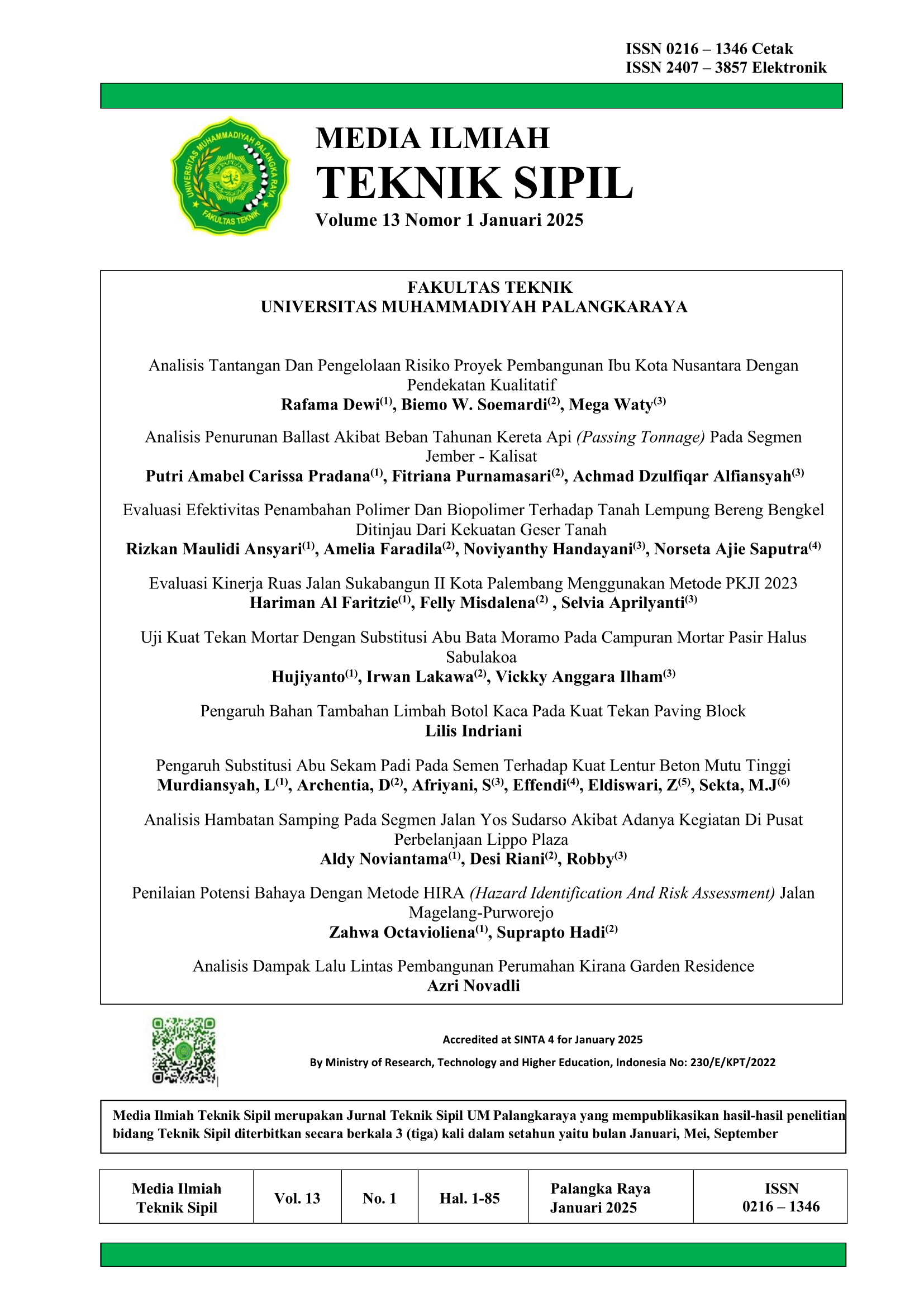Analisis Tantangan Dan Pengelolaan Risiko Proyek Pembangunan Ibu Kota Nusantara Dengan Pendekatan Kualitatif
Analysis Of Challenges And Risk Management Of The Archipelago Capital City Development Project With A Qualitative Approach
Abstract
The Nusantara Capital City (IKN) development project is one of the strategic megaprojects in Indonesia with the aim of moving the center of government to East Kalimantan. The megaproject faces a number of significant challenges, including delays in physical progress, budget constraints, constraints in land acquisition, and complex technical risks. This study aims to analyze the challenges and risk mitigation strategies implemented in the IKN project through a qualitative approach based on progress reports until September 2024. With thematic analysis using the NVivo tool, three main themes in risk mitigation were found, namely flexible financial management, the use of Building Information Modeling (BIM) technology, and a cross-sector collaborative approach. The use of BIM has proven to be effective in detecting design clash detection, which reduces technical risks in the field. In addition, the involvement of local governments and local communities in the land acquisition process accelerates negotiations and reduces the potential for social conflict. The results of this study show that cross-sector collaboration, technology integration, and adaptive budget management play an important role in ensuring the smooth running of large-scale projects. This study is expected to contribute to the development of risk management strategies in Indonesian infrastructure projects.
Downloads
References
Aaltonen, K., & Kujala, J. (2016). Towards an improved understanding of project stakeholder landscapes. International journal of project management. https://www.sciencedirect.com/science/article/pii/S0263786316300849
Abdullah, M. S., Azmi, M. I., & Rahman, N. A. (2019). Challenges in land acquisition for infrastructure projects: Lessons from Putrajaya, Malaysia. International Journal of Project Management, 37(4), 563–572. https://doi.org/10.1016/j.ijproman.2019.01.008
Beckers, F., Silva, E., Chiara, N., Flesch, A., Maly, J., & Stegemann, U. (2013). A risk-management approach to a successful infrastructure project: Initiation, financing, and execution. Documentos de trabajo de McKinsey sobre riesgo, 52.
Braun, V., & Clarke, V. (2006). Using thematic analysis in psychology. Qualitative Research in Psychology, 3(2), 77–101. https://doi.org/10.1191/1478088706qp063oa
Chong, H. Y., Lee, C. Y., & Wang, X. (2021). A new framework for managing social risk in construction projects: A comparative analysis between Malaysia and other countries. Journal of Construction Engineering and Management, 147(2), 4020011. https://doi.org/10.1061/(ASCE)CO.1943-7862.0001954
Creswell, J. W. (2018). Research design: Qualitative, quantitative, and mixed methods approaches (5th (Ed.)). SAGE Publications.
Deng, F., Ding, S., & Love, P. E. D. (2021). Risk management in large-scale construction projects: A systematic review and future research agenda. International Journal of Project Management, 39(5), 431–445. https://doi.org/10.1016/j.ijproman.2021.02.002
Denzin, N. K., Lincoln, Y. S., & 5th (Ed.). (2017). The SAGE handbook of qualitative research. SAGE Publications.
Flyvbjerg, B., Garbuio, M., & Lovallo, D. (2022). Delusion and deception in large infrastructure projects: Causes and cures. California Management Review, 58(3), 51–71. https://doi.org/10.1525/cmr.2016.58.3.51
Geraldi, J., Maylor, H., & Williams, T. (2011). Now, let’s make it really complex (complicated): A systematic review of the complexities of projects. International Journal of Operations and Production Management, 31(9), 966–990. https://doi.org/10.1108/01443571111165848
Goh, K. C., & Abdul-Rahman, H. (2021). Building information modeling (BIM) adoption for sustainable construction planning in Putrajaya, Malaysia. Journal of Cleaner Production, 250, 119493. https://doi.org/10.1016/j.jclepro.2019.119493
Guest, G., MacQueen, K. M., & Namey, E. E. (2011). Applied thematic analysis. SAGE Publications.
Kerzner, H. (2017). Project management: A systems approach to planning, scheduling, and controlling (12th (Ed.)). Wiley.
Mahalingam, A., Kashyap, R., & Mahajan, C. (2015). Managing risks in Indian mega-projects: Lessons from the Delhi metro rail project. Journal of Project Management, 46(1), 42–53. https://doi.org/10.1061/(ASCE)LM.1943-5630.0000203
Saldaña, J. (2021). The coding manual for qualitative researchers (4th (Ed.)). SAGE Publications.
Satgas, P. (2024). LAPORAN MONITORING PROGRES: Pembangunan Ibu Kota Nusantara. September.
Silverman, D. (2020). Qualitative Research. SAGE Publications.
Syahputra, A., & Hartono, D. (2023). Evaluating the economic impact of Indonesia’s new capital city project in East Kalimantan. Indonesian Journal of Economics and Development, 24(1), 14–26. https://doi.org/10.32485/ijeed.2023.24.1.2
Ward, S., & Chapman, C. (2018). How to manage project opportunity and risk: Why uncertainty management can be a much better approach than risk management. Wiley.
Yang, R. J., Zou, P. X., & Zhang, G. (2020). Stakeholders and their roles in construction projects: A critical review of project stakeholder management. Engineering, Construction and Architectural Management, 27(3), 646–661. https://doi.org/10.1108/ECAM-03-2019-0156
Yap, J. B., Abdul-Rahman, H., & Wang, C. (2022). BIM’s benefits for risk management in construction projects. Automation in Construction, 137, 104179. https://doi.org/10.1016/j.autcon.2022.104179
Yin, R. K. (2018). Case Study Research and Applications: Design and Methods. SAGE Publications.
Zhao, X., & Li, Y. (2023). Financial risks in large construction projects and their impact on project performance. Journal of Financial Management in Construction, 38(2), 189–202. https://doi.org/10.1108/JFMC-04-2023-0063
Zou, P. X. W., Zhang, G., & Wang, J. (2007). Understanding the key risks in construction projects in China. International Journal of Project Management, 25(6), 601–614. https://doi.org/10.1016/j.ijproman.2007.03.001
Downloads
Published
How to Cite
Issue
Section
License
Copyright (c) 2025 Rafama Dewi, Biemo W. Soemardi, Mega Waty

This work is licensed under a Creative Commons Attribution-ShareAlike 4.0 International License.
All rights reserved. This publication may be reproduced, stored in a retrieval system, or transmitted in any form or by any means, electronic, mechanical, photocopying, recording.
